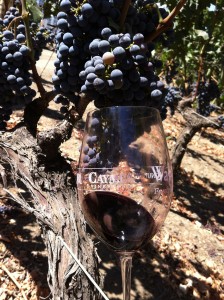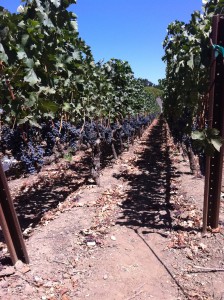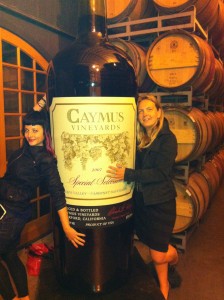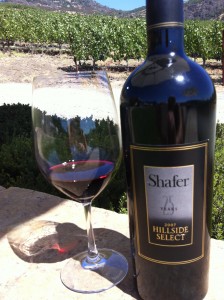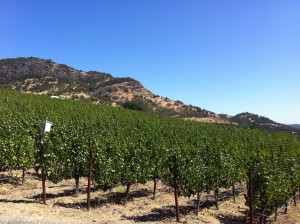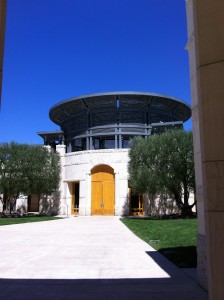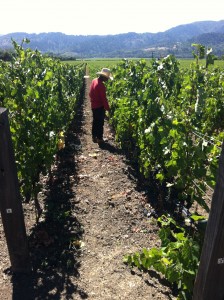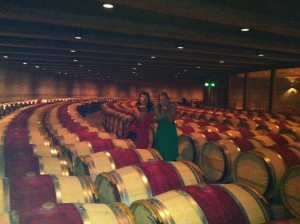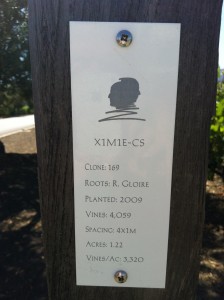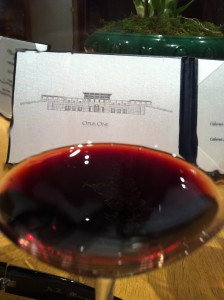One of the the goals Onneca Guelbenzu and I had set ourselves was to learn a little more about the iconic Napa cabs. Cabernet Sauvignon was among the first grape varieties which was planted in Napa at the end of the 19th century and it has steadily won in popularity to be the widest planted variety in Napa today. After the 1976 Judegement of Paris, when the 1973 Stags Leap Wine Cellars Cabernet took first place above 4 prestigious Bordeaux Premier Cru and Deuxieme cru’s, it became widely accepted that the Napa terroir and soil structure was particularly well suited to Cabernet Sauvignon. However – how would one define the Napa Valley terroir as there are believed to be at least 100 soil types in the Napa Valley…
Like most of the Northern Californian coast line, the Napa Valley is the result of continental drifts and plate tectonics – the valley itself is a former sea bed, now covered with sedimentary soils, which runs about 50 km north to south, wedged in between 2 mountain ranges: the Mayacamas Mountains in the west and the Vaca Mountain range in the east. Both mountain ranges are the result of volcanic activity and lava has also spilled into the valley – especially on the slopes. Besides its geological complexity the valley is also climatically diverse: temperatures can drop or rise significantly as one moves about the valley. This is why the valley is divided in 16 (sub) AVA’s, and in 15 of them Cabernet is King. The exception is Carneros, located in the most southern part of the valley, where it is too cool for Cabernet to flourish.
With so much Cabernet around and so little time where were we to start in our quest for iconic Napa Cab? In the end we decided on 3 producers who were all distributed worldwide, whose wines are a true expression of their specific terroir and who besides rising to cult status have none the less have stayed semi boutique Napa operations. And an added plus for me is that all 3 have been experiencing with sustainable and organic farming!
Caymus Vineyards was established in 1971 when Charlie and Lorna Belle Wagner convinced their 19 year old son Chuck to start a winery in Rutherford. The Wagner family had been farming grapes in Napa since 1906, but only in 1972 did they make their first wine – 240 cases of Rutherford Cabernet Sauvignon. The Wagner family picked the name Caymus from Rancho Caymus, the Mexican land grant which was given to George Yount which allowed him to settle in the Napa Valley. The land encompassed by the Rancho Caymus included Rutherford, where the Wagner homestead and their Napa vineyards are located.
The Rutherford AVA encompasses about 6 square miles, located in the widest part of the Napa Valley where it has a longer sun exposure then the rest of the valley. As everywhere in the valley the nights are cool, and the diurnal temperature differences allows the fruit to ripen at a steady pace. The soils are dominated by the Franciscan marine sedimentary materials with some volcanic deposits (primarily Bale, Pleasanton and Yolo loams).Vineyards are planted on deep and well-drained fans – which are are formed from shattered, well-bedded sandstone with a high gravel content – and very well suited to Cabernet Sauvignon.
Over the last 40 years the Caymus family successfully expanded the business, creating several other brands and are now selling over 200,000 cases of wine. The Caymus name however, remains exclusively linked to their Napa Valley wines, and the focus in Napa is still on Cabernet Sauvignon. Today Caymus produces two Cabernet Sauvignons, which are both pretty rich in style. Chuck, who today is the chief winemaker, believes in letting the fruit “hang” extensively, allowing for full phenolic ripeness, hence he tends to pick quite late in the season. He likes the suppleness, deep color and matures tannins the extensive hang time brings to the wines. Chuck has also been experiencing with sustainable and organic farming, and the home block vineyard boosts a small orchard of fruit trees as well as lots of flowers to stimulate a diverse ecosystem.We tried both Cabernets and I was amazed by the difference in flavor and style. The 2010 Caymus Vineyard Napa Valley Cabernet Sauvignon was quite fresh on the nose with lots of eucalyptus notes. On the palate, besides the layers of blue and black fruit again there was this fresh kitchen herb (thyme, rosemary and even mint) characteristic. The 2009 Caymus Vineyard Special Selection was richer and also a little more complex. I was impressed with the velvet characteristic of the tannins and how drinkable this wine was right now, after just being released. Again there were layers of blue and black berries, a hint of roasted fennel and some cocoa and coffee notes in the back palate.
We were told that Caymus prides itself on producing wines that are as approachable in youth as well at maturity and both Cabernets certainly proved this statement
John Shafer moved his family from Illinois to California in 1972 when bought a property of 210 acres (just under 85 hectare) in Stags Leaps. The property had an existing 30 acre vineyard of Zinfandel but as John had his heart set on Cabernet Sauvignon he created small hillside vineyard blocks where he planted Cabernet.
The Stags Leap District was the first appellation to be designated an AVA based on the unique terroir characteristics of its soil. The district is located in the eastern part of the Napa Valley and is barely a mile wide and three miles long. The two main soil types are the old river sediments of loams with a clay-like substructure in the lowlands and volcanic soil deposits left over from erosion of the Vaca Mountains on the eastern elevations. Both types are rich in coarse gravely soils resulting in low-vigor Cabernet Sauvignon vines that yield fruit of great intensity and flavor.
In 1978 Shafer produced its first vintage – 1000 cases of Cabernet Sauvignon, a wine which made quite an impression as it won the acclaimed San Francisco Vintners Club taste-off upon release in 1981. 12 years later, this same wine took first place in an international competition in Germany, outranking Chateau Latour and Chateau Margaux. It remained the bench mark for all future Shafer vintages and wine makers Doug Shafer and Elias Fernandez, have relentlessly strived to maintain and even improve the quality of their Cabernet.In 1983, Doug convinced his father to produce the Hillside Select Cabernet Sauvignon – produced from the best block on the original Hillside vineyard. It is this wine which has made the Shafer reputation as an iconic Cabernet producer. We tasted the 2007 25 years Hillside Select Cabernet, a wine just about purple in colour, with an elegant nose (floral notes, bright red fruit and eucalyptus) and a complex palate. The wine was fresh and full of flavour, with almost silky tannins – I loved how the layers of black fruit (cherry, dark juicy plum, blackberry and mulberry) were interwoven with herbaceous notes. To me this wine showed great potential and whilst it was pretty delicious when we tasted it I think the best is yet to come if we allow it a few more years of cellaring.
The Shafers have always focused on the vineyard – John, Doug and Elias have been absorbed in understanding their particular Napa Valley terroir right from the start and have developed an in depth knowledge of their soils, climate and fruit over the last years. This lead them 20 years ago to embrace the principles of sustainable wine growing: from planting cover crops in between the rows and making their own compost to enrich the soils in a natural way to encouraging birds of prey to find a home in their vineyards and help them combat the rodents. In 2004 they moved to using only solar energy to power the farm and winery and from 2008 they have been reusing and recycling their water. Over the years they have expanded and bought more vineyards in Carneros and Oak Knoll and today’s production has increased to 32,000 cases. Opus OneOpus One was founded in 1979 and was the brain child of Baron Philippe de Rothschild and Robert Mondavi. These 2 visionary men set out to produce a super premium Bordeaux Blend based on Cabernet Sauvignon in Napa’s premium Oakville area.
Oakville is a small AVA located in the middle of the Napa Valley and stretches out over 5700 cares of which 5000 are planted. The soils are primarily made up of decomposed volcanic rocks from the eastern Vaca and western Mayacamas and silt, clay and gravel deposits left behind by the the Napa River. The weather is a little cooler, as Oakville is low enough to benefit of the cooling fog and winds which roll in from the pacific ocean and has full sun exposure from late morning till late evening. These conditions once again are ideal to grow Cabernet Sauvignon and other Bordeaux varieties.
The first Opus One vines were planted in 1984 according to a tightly spaced planting schema. The plant density stimulates competition and as Opus One has very few bunches per plant it makes for intense fruit flavours. The fact that the rows are quite close together also means that just about everything is done by hand – except for the hedging which is done with a special tractor. Opus One employs 20 full time vineyard workers and many of them have been with the company for a long time and know the 3 company vineyards inside out. These workers spend their days among the vines and part of their daily duty is to actively look for changes in the plants – this close monitoring allows Opus One to have a very healthy vineyard, to pre-empt diseases and be very reactive.The vineyard is planted with Bordelais varieties – 80% of the plantings are Cabernet Sauvignon, and the remaining 20 % is made up of Merlot, Cabernet Franc, Petit Verdot and Malbec. The winery, designed by LA architect Scott Johnson, was completed in 1991 and is an amazing building both aesthetically and from a winemaking perspective. The grape processing is gravity fed and at the lowest level is a large barrel hall to age the wines. As in the vineyard, everything is closely monitored in the winery as well to assure the highest quality possible. Expensive precision sorting machinery is used to assist with the sorting and every cork is test for cork taint before bottling. Originally the winemaking was shared between the winemaking teams from Mondavi and Mouton, but since 2001 Michael Silacci has been appointed the winemaker. Michael has made several changes in the vineyard, including the conversion to dry farming and has been experimenting with organic and biodynamic farming on some of plots of the vineyard. Silacci aims to produce wines, which truly reflects the terroir and the vineyard and that is why he does not make any must adjustments – no tannin nor acid is added, nor is the must watered down or dealcoholized. He feels the balance needs to come from the fruit itself, and that is why he is very involved in the vineyard and has even embarked on a total replanting project which will take about 30 years to be completed to not impact the production too much. The flagship wine is Opus One, a wine made in the great Bordelais traditions but at the same time a wine which strives to expresses all the potential of the Oakville terroir. We tasted the 2003 and the 2008 vintages – both wines showed very well. The 2003 vintage, a blend of 91% Cabernet Sauvignon, 3% Cabernet Franc, 3% Petit Verdot, 2% Merlot and 1 % Malbec, just about jumped out of the glass and I was enthralled by its velvety tannins, great acidity and the wonderfully rich layers of red and black fruit and the orange clove & fennel notes in the finish. However, it was obvious this wine was just a beautiful teenager, showing promise of turning into a very handsome and desirable adult in a few more years!
The 2008 vintage (86% Cabernet Sauvignon, 8% Petit Verdot, 4% Merlot and 1% Cabernet Franc and Malbec) was but a toddler, yet again I was impressed by the approachability of this wine – it was definitely enjoyable to taste and drink. It showed more herbaceous notes – coriander seed, aniseed and a little garique and eucalyptus – and the tannins were little more fine-grained and pronounced as was the acidity. Again it showed lots of promise for the future and it is definitely an iconic Napa Cabernet (blend).
This very small sample of Napa Cabs we tasted showed indeed 2 things. Firstly Napa Valley has definitely the potential to create excellent Cabernet Sauvignons, which are actually drinkable and enjoyable to drink upon their release, yet they definitely have the potential to age gracefully and seduce when they are a little more mature. Secondly, the wines we tasted were very different – each was the expression of their specific terroir – by this I mean the actual piece of dirt from which they came as well as the interpretation of the winemaker. As they say here in France, one needs a person with a vision to bring out all the potential of a great terroir!

